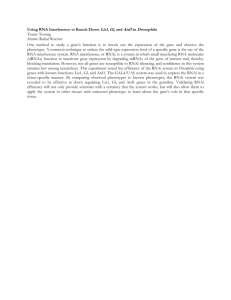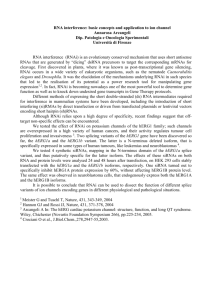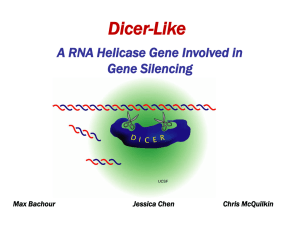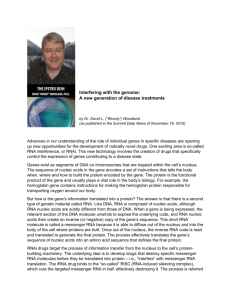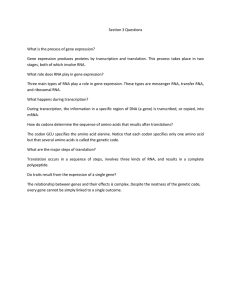RNA Interference in Neurobiology
advertisement
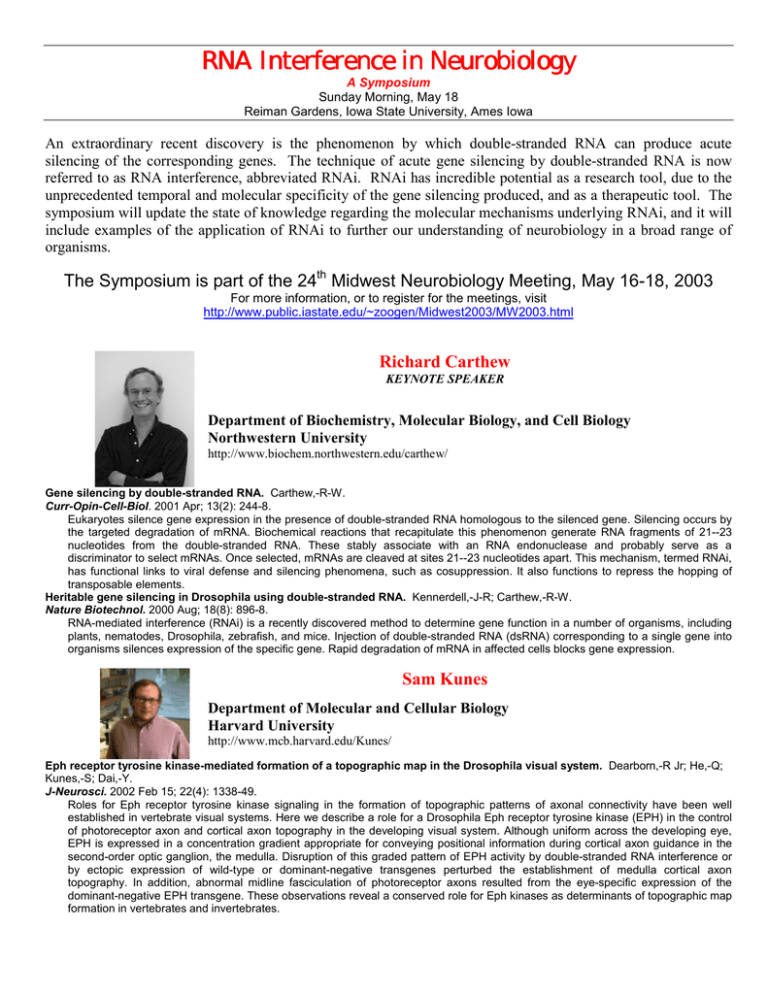
RNA Interference in Neurobiology A Symposium Sunday Morning, May 18 Reiman Gardens, Iowa State University, Ames Iowa An extraordinary recent discovery is the phenomenon by which double-stranded RNA can produce acute silencing of the corresponding genes. The technique of acute gene silencing by double-stranded RNA is now referred to as RNA interference, abbreviated RNAi. RNAi has incredible potential as a research tool, due to the unprecedented temporal and molecular specificity of the gene silencing produced, and as a therapeutic tool. The symposium will update the state of knowledge regarding the molecular mechanisms underlying RNAi, and it will include examples of the application of RNAi to further our understanding of neurobiology in a broad range of organisms. The Symposium is part of the 24th Midwest Neurobiology Meeting, May 16-18, 2003 For more information, or to register for the meetings, visit http://www.public.iastate.edu/~zoogen/Midwest2003/MW2003.html Richard Carthew KEYNOTE SPEAKER Department of Biochemistry, Molecular Biology, and Cell Biology Northwestern University http://www.biochem.northwestern.edu/carthew/ Gene silencing by double-stranded RNA. Carthew,-R-W. Curr-Opin-Cell-Biol. 2001 Apr; 13(2): 244-8. Eukaryotes silence gene expression in the presence of double-stranded RNA homologous to the silenced gene. Silencing occurs by the targeted degradation of mRNA. Biochemical reactions that recapitulate this phenomenon generate RNA fragments of 21--23 nucleotides from the double-stranded RNA. These stably associate with an RNA endonuclease and probably serve as a discriminator to select mRNAs. Once selected, mRNAs are cleaved at sites 21--23 nucleotides apart. This mechanism, termed RNAi, has functional links to viral defense and silencing phenomena, such as cosuppression. It also functions to repress the hopping of transposable elements. Heritable gene silencing in Drosophila using double-stranded RNA. Kennerdell,-J-R; Carthew,-R-W. Nature Biotechnol. 2000 Aug; 18(8): 896-8. RNA-mediated interference (RNAi) is a recently discovered method to determine gene function in a number of organisms, including plants, nematodes, Drosophila, zebrafish, and mice. Injection of double-stranded RNA (dsRNA) corresponding to a single gene into organisms silences expression of the specific gene. Rapid degradation of mRNA in affected cells blocks gene expression. Sam Kunes Department of Molecular and Cellular Biology Harvard University http://www.mcb.harvard.edu/Kunes/ Eph receptor tyrosine kinase-mediated formation of a topographic map in the Drosophila visual system. Dearborn,-R Jr; He,-Q; Kunes,-S; Dai,-Y. J-Neurosci. 2002 Feb 15; 22(4): 1338-49. Roles for Eph receptor tyrosine kinase signaling in the formation of topographic patterns of axonal connectivity have been well established in vertebrate visual systems. Here we describe a role for a Drosophila Eph receptor tyrosine kinase (EPH) in the control of photoreceptor axon and cortical axon topography in the developing visual system. Although uniform across the developing eye, EPH is expressed in a concentration gradient appropriate for conveying positional information during cortical axon guidance in the second-order optic ganglion, the medulla. Disruption of this graded pattern of EPH activity by double-stranded RNA interference or by ectopic expression of wild-type or dominant-negative transgenes perturbed the establishment of medulla cortical axon topography. In addition, abnormal midline fasciculation of photoreceptor axons resulted from the eye-specific expression of the dominant-negative EPH transgene. These observations reveal a conserved role for Eph kinases as determinants of topographic map formation in vertebrates and invertebrates. Ken Kosik Brigham and Women's Hospital Harvard University http://www.hms.harvard.edu/dms/bbs/fac/kosik.html RNAi functions in cultured mammalian neurons. Krichevsky,-A-M; Kosik,-K-S. Proc-Natl-Acad-Sci-U-S-A. 2002 Sep 3; 99(18): 11926-9. In a wide range of organisms, double-stranded RNA triggers posttranscriptional gene silencing or RNA interference (RNAi). Small interfering RNAs, the 21-nt double-stranded RNA intermediates of this natural pathway, have became a powerful tool to knock down specific gene expression in mammalian cell lines and potentially will be useful for the analysis of loss-of-function phenotypes. In mammalian primary neuronal cultures, where genetic manipulations are especially difficult, RNAi might be developed into a highly efficacious tool to study the roles of specific genes in neuron development and functioning. Neurons, however, have been considered the most resistant to RNAi. We report here an application of RNAi to postmitotic primary neuronal cultures. Synthetic siRNA can be readily introduced into neurons and effectively inhibit the expression of endogenous and transfected genes. Beverly Davidson Iowa Center for Gene Therapy University of Iowa http://www.medicine.uiowa.edu/davidsonlab/ siRNA-mediated gene silencing in vitro and in vivo. Xia,-H; Mao,-Q; Paulson,-H-L; Davidson,-B-L. Nature Biotechnol. 2002 Oct; 20(10): 1006-10. RNA interference is now established as an important biological strategy for gene silencing, but its application to mammalian cells has been limited by nonspecific inhibitory effects of long dsRNA on translation. Here, we describe a viral-mediated delivery mechanism that results in specific silencing of targeted genes through expression of small interfering RNA (siRNA). We establish proof of principle by markedly diminishing expression of exogenous and endogenous genes in vitro and in vivo in brain and liver, and further apply this strategy to a model system of a major class of neurodegenerative disorders, the polyglutamine diseases, to show reduced polyglutamine aggregation in cells. This viral-mediated strategy should prove generally useful in reducing expression of target genes to model biological processes or to provide therapy for dominant human diseases Dean Smith Center for Basic Neuroscience Southwestern Medical Center http://www2.swmed.edu/cbn/smith.htm Novel genomic cDNA hybrids produce effective RNA interference in adult Drosophila. Kalidas,-S; Smith,-D-P. Neuron. 2002 Jan 17; 33(2): 177-84. Drosophila melanogaster has been a premier genetic model system for nearly 100 years, yet lacks a simple method to disrupt gene expression. Here, we show genomic cDNA fusions predicted to form double-stranded RNA (dsRNA) following splicing, effectively silencing expression of target genes in adult transgenic animals. We targeted three Drosophila genes: lush, white, and dGq(alpha). In each case, target gene expression is dramatically reduced, and the white RNAi phenotype is indistinguishable from a deletion mutant. This technique efficiently targets genes expressed in neurons, a tissue refractory to RNAi in C. elegans. These results demonstrate a simple strategy to knock out gene function in specific cells in living adult Drosophila that can be applied to define the biological function of hundreds of orphan genes and open reading frames. Alejandro Sánchez Alvarado Department of Neurobiology and Anatomy University of Utah Medical School http:// planaria.neuro.utah.edu/ FGFR-related gene nou-darake restricts brain tissues to the head region of planarians. Cebria,-F; Kobayashi,-C; Umesono,-Y; Nakazawa,-M; Mineta,-K; Ikeo,-K; Gojobori,-T; Itoh,-M; Taira,-M; Alvarado,-A-S; Agata,-K. Nature. 2002 Oct 10; 419(6907): 620-4. The study of planarian regeneration may help us to understand how we can rebuild organs and tissues after injury, disease or ageing. The robust regenerative abilities of planarians are based upon a population of totipotent stem cells (neoblasts), and among the organs regenerated by these animals is a well-organized central nervous system. In recent years, methodologies such as wholemount in situ hybridizations and double-stranded RNA have been extended to planarians with the aim of unravelling the molecular basis of their regenerative capacities. Here we report the identification and characterization of nou-darake (ndk), a gene encoding a fibroblast growth factor receptor (FGFR)-like molecule specifically expressed in the head region of the planarian Dugesia japonica. Loss of function of ndk by RNA interference results in the induction of ectopic brain tissues throughout the body. This ectopic brain formation was suppressed by inhibition of two planarian FGFR homologues (FGFR1 and FGFR2). Additionally, ndk inhibits FGF signalling in Xenopus embryos. The data suggest that ndk may modulate FGF signalling in stem cells to restrict brain tissues to the head region of planarians.
